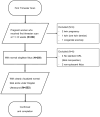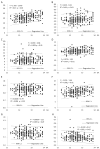Fetal Aortic Blood Flow Velocity and Power Doppler Profiles in the First Trimester: A Comprehensive Study Using High-Definition Flow Imaging
- PMID: 38671799
- PMCID: PMC11048424
- DOI: 10.3390/bioengineering11040378
Fetal Aortic Blood Flow Velocity and Power Doppler Profiles in the First Trimester: A Comprehensive Study Using High-Definition Flow Imaging
Abstract
Objectives: This study aimed to establish reference values for fetal aortic isthmus blood flow velocity and associated indices during the first trimester, utilizing a novel ultrasonographic technique known as high-definition flow imaging (HDFI). Additionally, the correlation between Doppler profiles of aortic blood flow and key fetal parameters, including nuchal thickness (NT), crown-rump length (CRL), and fetal heartbeat (FHB), was investigated.
Methods: A total of 262 fetuses were included in the analysis between December 2022 and December 2023. Utilizing 2D power Doppler ultrasound images, aortic blood flow parameters were assessed, including aortic peak systolic velocity (PS), aortic end-diastolic velocity (ED), aortic time average maximal velocity (TAMV), and various indices such as aortic systolic velocity/diastolic velocity (S/D), aortic pulsatile index (PI), aortic resistance index (RI), aortic isthmus flow velocity index (IFI), and aortic isthmic systolic index (ISI). Concurrently, fetal FHB, NT, and CRL were evaluated during early trimester Down syndrome screening.
Results: Significant findings include a positive correlation between gestational age (GA) and PS (PS = 3.75 × (GA) - 15.4, r2 = 0.13, p < 0.01), ED (ED = 0.42 × (GA) - 0.61, r2 = 0.04, p < 0.01), PI (PI = 0.07 × (GA) + 1.03, r2 = 0.04, p < 0.01), and TAMV (TAMV = 1.23 × (GA) - 1.66, r2 = 0.08, p < 0.01). In contrast, aortic ISI demonstrated a significant decrease (ISI = -0.03 × (GA) + 0.57, r2 = 0.05, p < 0.05) with gestational age. No significant correlation was observed for aortic RI (p = 0.33), S/D (p = 0.39), and IFI (p = 0.29) with gestational age. Aortic PS exhibited positive correlations with NT (0.217, p = 0.001) and CRL (0.360, p = 0.000) but a negative correlation with FHB (-0.214, p = 0.001). Aortic PI demonstrated positive correlations with CRL (0.208, p = 0.001) and negative correlations with FHB (-0.176, p = 0.005). Aortic TAMV showed positive correlations with NT (0.233, p = 0.000) and CRL (0.290, p = 0.000) while exhibiting a negative correlation with FHB (-0.141, p = 0.026). Aortic ISI demonstrated negative correlations with NT (-0.128, p = 0.045) and CRL (-0.218, p = 0.001) but a positive correlation with FHB (0.163, p = 0.010).
Conclusions: Power Doppler angiography with Doppler ultrasound demonstrates the ability to establish accurate reference values for fetal aortic blood flow during the first trimester of pregnancy. Notably, aortic PS, TAMV, and ISI exhibit significant correlations with NT, CRL, and FHB, with ISI appearing more relevant than IFI, PS, TAMV, and FHB. The utilization of HDFI technology proves advantageous in efficiently detecting the site of the aortic isthmus compared to traditional color Doppler mode in early second trimesters.
Keywords: aortic isthmus; fetus; first-trimester screening; high-definition flow imaging (HDFI); isthmic flow index; isthmic systolic index; power Doppler ultrasound.
Conflict of interest statement
None of the authors has a financial or other conflict of interest.
Figures




Similar articles
-
Profiling left and right ventricular proportional output during fetal life with a novel systolic index in the aortic isthmus.Ultrasound Obstet Gynecol. 2014 Aug;44(2):176-81. doi: 10.1002/uog.13345. Epub 2014 Jun 30. Ultrasound Obstet Gynecol. 2014. PMID: 24585706
-
Echo-Doppler ultrasonographic assessment of resistance and velocity of blood flow in the ductus venosus throughout gestation in fetal lambs.Theriogenology. 2008 Sep 1;70(4):648-54. doi: 10.1016/j.theriogenology.2008.04.027. Epub 2008 May 27. Theriogenology. 2008. PMID: 18508117
-
Effect of fetal gender on first-trimester ductus venosus blood flow.Ultrasound Obstet Gynecol. 2003 Sep;22(3):268-70. doi: 10.1002/uog.205. Ultrasound Obstet Gynecol. 2003. PMID: 12942499
-
Reference values for an index of fetal aortic isthmus blood flow during the second half of pregnancy.Ultrasound Obstet Gynecol. 2003 May;21(5):441-4. doi: 10.1002/uog.105. Ultrasound Obstet Gynecol. 2003. PMID: 12768553
-
Blood flow in the fetal descending aorta.Semin Perinatol. 1987 Oct;11(4):322-34. Semin Perinatol. 1987. PMID: 3321452 Review.
References
LinkOut - more resources
Full Text Sources
Research Materials
Miscellaneous

